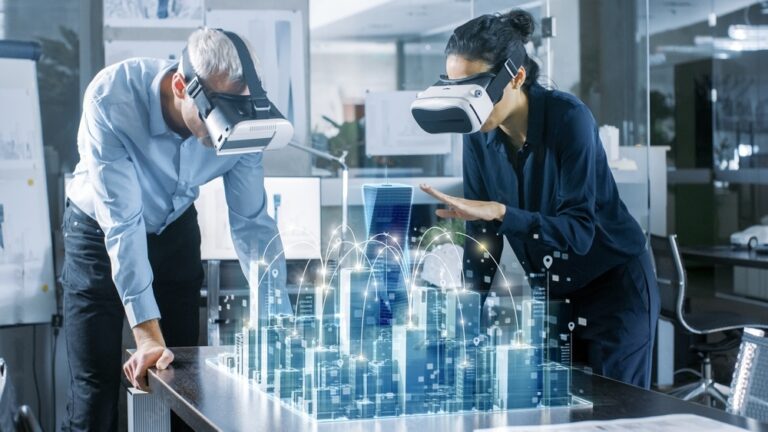Architecture and Virtual Reality

Welcome to a place where imagination mixes with the real world, where architects use special tech to create amazing buildings before they’re even built. Picture walking into a world where buildings talk to you, and you can touch them with your hands. That’s what virtual reality (VR) does for architecture – it lets us go on a wild adventure where anything is possible.
In this journey, we’ll uncover how this cool tech is changing how we design, learn, and experience buildings. So, put on your virtual goggles, and let’s dive into the exciting world where tomorrow’s dreams become today’s reality.
Virtual Reality’s Ascent in Architecture
The advent of virtual reality technology has ushered in a new era for architectural design, offering architects the ability to transcend traditional two-dimensional blueprints and immerse themselves in fully-realized three-dimensional environments.
Architects can now step inside their creations, scrutinizing every angle, dimension, and detail before a single brick is laid. This immersive experience not only enhances design precision but also facilitates more intuitive decision-making.
From industry giants like Foster + Partners utilizing VR for large-scale projects to independent designers experimenting with VR modeling tools, the architecture community is embracing this technological revolution with open arms.
Educating the Architects of Tomorrow
In architectural education, virtual reality serves as a dynamic pedagogical tool, providing students with unparalleled opportunities to explore, experiment, and engage with architectural concepts in a hands-on manner.
VR simulations allow students to dissect iconic structures, manipulate design elements, and even simulate real-world construction challenges within a safe and controlled environment.
Institutions worldwide, such as the Architectural Association School of Architecture in London, are integrating VR into their curricula, equipping aspiring architects with the skills and insights needed to thrive in an increasingly digital landscape.
Virtual Reality’s Impact on Architectural Creativity
Virtual reality fuels architectural creativity by transcending the limitations of traditional design mediums and empowering architects to unleash their imaginations without constraints.
Design iterations become fluid and iterative as architects can seamlessly modify and visualize their concepts in real-time, leading to more innovative and daring architectural solutions.
Visionary architects like Ma Yansong of MAD Architects are leveraging VR to push the boundaries of conventional design, envisioning futuristic cityscapes and sustainable habitats that blur the line between science fiction and reality.
Immersive Architecture in Virtual Reality
Virtual reality transforms architecture from static blueprints into dynamic, experiential narratives, inviting users to embark on immersive journeys through past, present, and future spaces.
From virtual tours of historical landmarks to interactive exhibitions showcasing speculative designs, VR enables users to engage with architecture on a visceral level, fostering a deeper appreciation for the built environment.
Cultural institutions like the Smithsonian Institution are embracing VR to create immersive experiences that transcend geographical boundaries, allowing audiences worldwide to explore architectural wonders from the comfort of their homes.
Harnessing Virtual Reality for Architectural Collaboration
Virtual reality fosters collaboration among architects, clients, and stakeholders by providing a shared platform where ideas can be visualized, communicated, and refined collaboratively.
Remote teams can converge in virtual environments, facilitating real-time design reviews, brainstorming sessions, and stakeholder consultations regardless of geographical distances.
Innovative VR collaboration tools like IrisVR and The Wild are revolutionizing the way architectural teams collaborate, streamlining workflows and enhancing communication in the digital age.
The Future of Virtual Architecture
Looking ahead, the future of virtual architecture holds boundless potential, from augmented reality overlays that seamlessly integrate digital and physical environments to generative design algorithms that optimize structures for both aesthetics and performance.
As VR technology continues to evolve, architects will have access to increasingly sophisticated tools and simulations, enabling them to envision, design, and inhabit tomorrow’s landscapes with unprecedented clarity and precision.
From sustainable urban planning initiatives to immersive virtual worlds that redefine the concept of space, the possibilities for virtual architecture are limited only by our imagination.
Conclusion
In closing, by harnessing the transformative power of VR, architects are not only pushing the boundaries of design but also democratizing access to architectural education and redefining the way we interact with the spaces around us. As we stand on the precipice of a new architectural renaissance, let us embrace the boundless possibilities that virtual reality affords, and together, build the future of tomorrow’s worlds.
